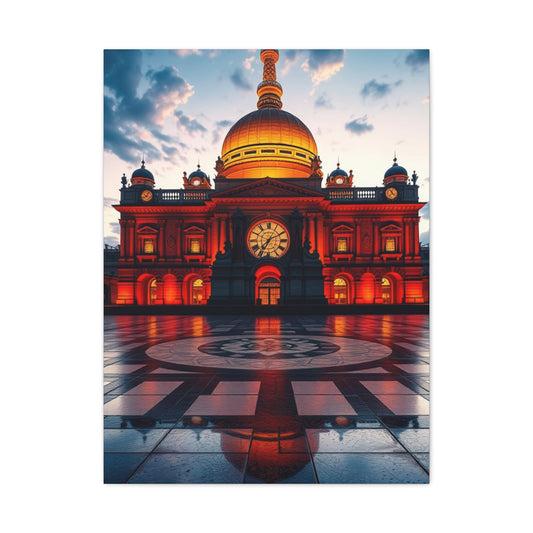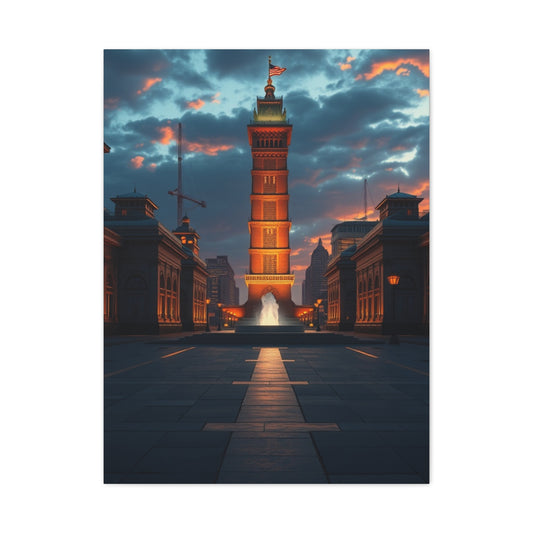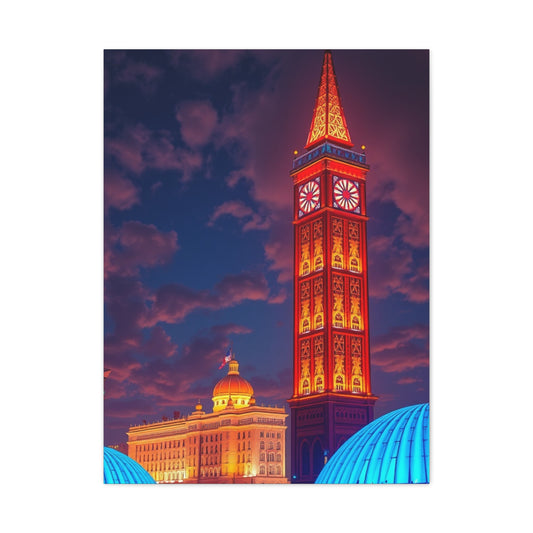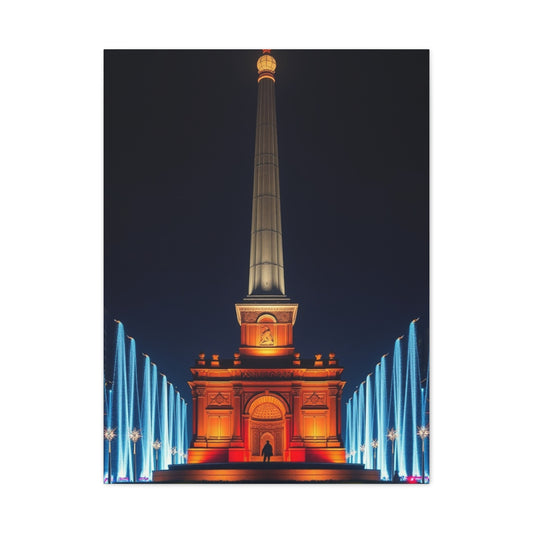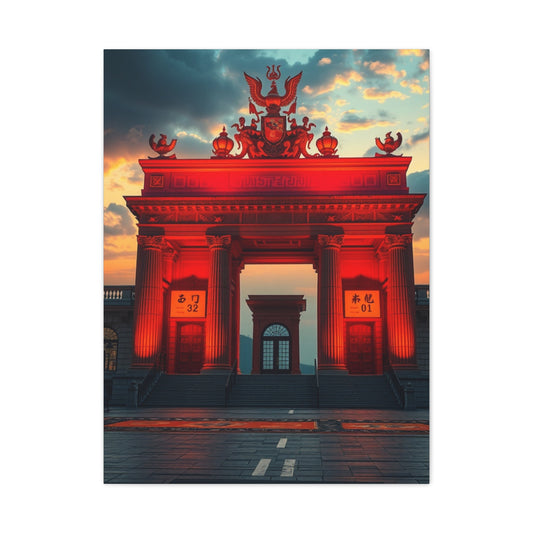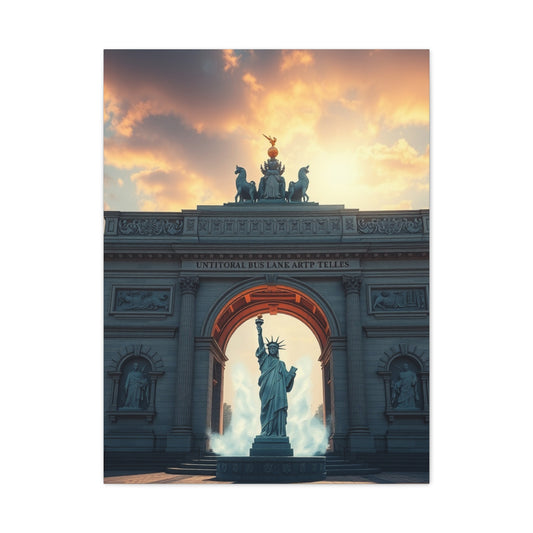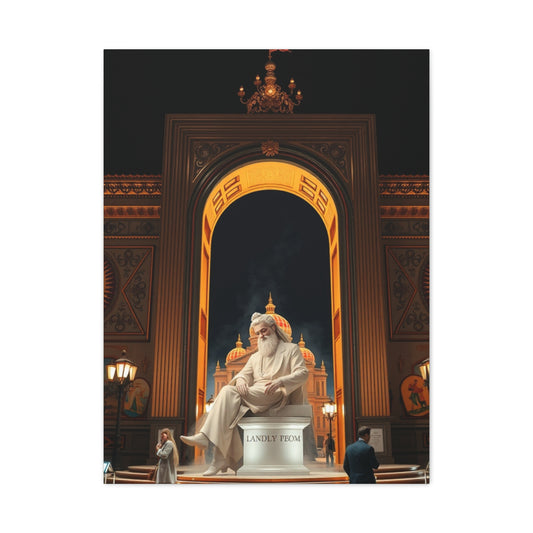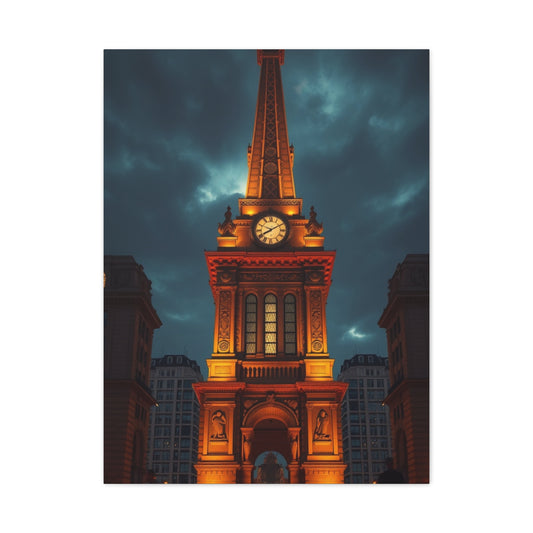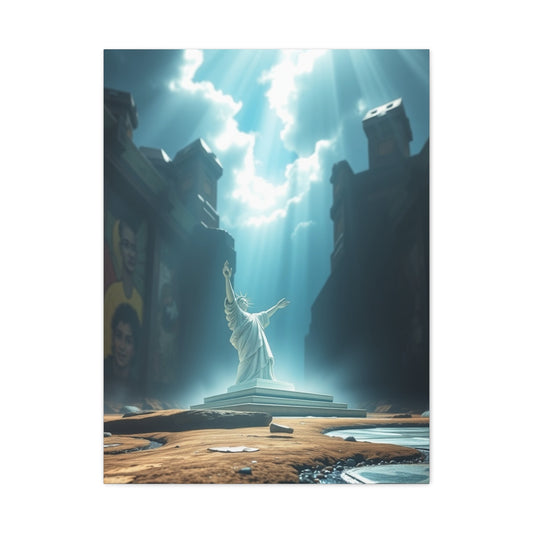Landmark Wall Art: Iconic Places Captured in Prints
A picture book can hold within its pages far more than images and text; it can become a gateway into history, artistry, and imagination. Several years ago, I had the immense privilege of illustrating The Buildings That Made…, a children’s title written by the distinguished historian David Long and published by Bloomsbury Children’s Books. The project demanded months of research, exploration, and creative dedication, but it rewarded me with one of the most formative experiences of my artistic career. What began as a commission grew into a lifelong fascination with architecture and heritage, and it opened the path for an ever-expanding collection of illustrated prints and exhibitions.
Every drawing within that book was more than an architectural rendering. Each landmark carried within it layers of stories, traditions, and meaning that I was challenged to capture for young readers and art lovers alike. From the ornate façade of the Natural History Museum to the domes of St Paul’s Cathedral, from the Gothic silhouette of Tower Bridge to the sweeping grounds of Buckingham Palace, these illustrations became both educational and decorative, inviting viewers into a dialogue between past and present. The book’s cover itself evolved into a special fine art print, while my illustrated map gathered the entire collection of iconic landmarks into one celebratory piece.
The project became a turning point that extended beyond the page. I went on to host a solo exhibition in Carnaby Street, release signed prints on textured, FSC-certified fine art paper, and receive commissions for beloved institutions such as Waterstones Piccadilly. Through these ventures, my art journey deepened into a commitment to making architecture accessible, cherished, and visible in homes across the world.
This first part explores the historical background of these architectural treasures, the concepts that guide illustrative interpretation, the categories of art prints that have emerged from such work, and their many practical applications. The intention is to reveal not only the artistry behind the process but also the cultural resonance of preserving architecture through illustration.
Historical Background
The story of these architectural marvels stretches back centuries. Their forms have been shaped by wars, monarchs, revolutions in thought, and the evolution of craftsmanship. They are not simply stone, steel, or glass but chronicles of eras.
Take the Natural History Museum, for instance, with its Romanesque terracotta façade adorned with sculpted flora and fauna. Constructed in the Victorian era, it represented the age’s thirst for knowledge and scientific discovery. The decorative detail on its walls is a physical testament to humankind’s curiosity about nature and the universe. Similarly, the Victoria and Albert Museum was born out of a vision to celebrate applied arts and design. Its collections and architecture embody the 19th century’s desire to elevate craftsmanship, artistry, and cultural exchange.
St Paul’s Cathedral tells a different narrative altogether. Rising from the ashes after the Great Fire of 1666, it became not only a place of worship but also a monument to resilience. Its dome dominates the skyline, echoing both Renaissance ideals and English ingenuity. Tower Bridge, on the other hand, emerged during the Industrial Revolution, combining engineering prowess with Neo-Gothic ornamentation, symbolising an era of both innovation and grandeur.
Beyond these monumental structures, the essence of the place also lies in its more modest corners. While working on the illustrations, I lived in Balham, a leafy neighbourhood where Victorian terraced houses, common parks, and independent shops offered respite from the bustle of the centre. This proximity allowed me to balance grand architectural research with everyday observation of domestic heritage. From bustling markets to cosy pubs, these environments shaped my understanding of how architecture can define not just history, but lived experience.
The layered past of these buildings reveals a city that is both ancient and modern, steadfast and ever-changing. For an illustrator, this layering provides an endless reservoir of inspiration. Each keystone, spire, and arch holds echoes of rulers, artisans, and ordinary citizens who passed through their thresholds.
Core Concepts and Foundations
Illustrating a book of this scale required not only technical precision but also a philosophical approach. Several key concepts became the foundations of my work.
The first was authenticity through research. Before committing pen to paper, I studied maps, engravings, and architectural drawings. I explored the Underground system to understand spatial relationships between districts, ensuring that my representations carried geographical logic. Most importantly, I visited each site in person. The gleam of rain on Tower Bridge, the hushed reverence inside the British Museum, or the play of light through the Palm House at Kew Gardens were details only visible by standing there.
The second foundation was narrative. A children’s picture book must go beyond accuracy; it must inspire curiosity. Each illustration was designed not merely to show, but to tell. The Natural History Museum print, for example, included border details of whales, beetles, and fossils, inviting children to notice and inquire. The V&A artwork featured ceramic motifs and Tipu’s Tiger, turning the page into a cabinet of wonders. These flourishes carried meaning beyond bricks and mortar, revealing the spirit of the institution.
Third came pattern and ornament. My personal style leans toward intricate repetition, symmetry, and decorative detail, drawing from traditions like the Arts and Crafts movement. By weaving ornamental patterns into the artwork, I ensured the illustrations resonated with a sense of continuity between architecture and design. The Liberty print, adorned with a floral motif inspired by archival textiles, is an example of this approach.
Finally, there was accessibility. Art should not remain confined to museums or libraries; it should live within daily spaces. By producing signed, high-quality reproductions, I sought to democratise the ownership of cultural heritage. Whether through a Map of the City print that gathered dozens of landmarks or a personalised neighbourhood piece like my Balham illustration, the aim was to make the experience intimate, approachable, and personal.
Types and Categories
Over time, my body of work began to fall naturally into distinct categories, reflecting both artistic intent and audience preference.
One category is the single-landmark print. These are focused portraits of architectural icons, such as Buckingham Palace, the British Museum, or Liberty. They distil the essence of a place, often accompanied by border elements that reference its collections, history, or spirit. Such works appeal to individuals with personal ties—memories of a first visit, a family outing, or a lifelong admiration.
Another category is the composite print. My Map print exemplifies this, gathering landmarks from across the city into one intricate panorama. These prints serve almost like illustrated puzzles, encouraging viewers to recognise and identify structures. They invite engagement not just as art but as playful, participatory experiences.
A further category embraces thematic or cultural moments. The Carnaby Street print, for example, celebrates not only the architecture of the district but its vibrant association with music, fashion, and counterculture. Figures like Jimi Hendrix, Amy Winehouse, and Mary Quant appear within the scene, blending architecture with cultural heritage.
Then there are personalised neighbourhood prints. My Balham illustration, created as a gift for my partner, immortalised our favourite cafes, bakeries, and parks, down to the local post office and barber. These pieces capture the poetry of ordinary places, proving that art can dignify the everyday alongside the monumental.
Finally, there are narrative prints. These tell stories through atmosphere and detail rather than static depiction. The Waterstones Piccadilly illustration shows shoppers with umbrellas, red bus lights cutting through mist, and shelves glowing from inside the windows. Such works place the viewer within the scene, offering not only architecture but lived experience.
Practical Applications
The journey of architectural illustration extends beyond the studio, influencing homes, galleries, education, and cultural identity.
In domestic spaces, prints become deeply personal artefacts. A family might hang a depiction of St Paul’s Cathedral as a reminder of a significant visit, or a Map print as a celebration of their connection to the place. For those living abroad, these pieces provide a cherished link to their origins. Because each print is produced on textured fine art paper and hand-signed, they straddle the boundary between decorative art and collectible treasure.
In public contexts, illustrated works enrich exhibitions and institutions. My solo exhibition in Carnaby Street transformed a gallery into a vibrant celebration of architecture and culture, while commissions like Waterstones Piccadilly demonstrated how retail spaces benefit from site-specific art. Such collaborations bring art into the rhythms of daily life, reinforcing the identity of places and institutions.
Educationally, illustrations of buildings provide engaging entry points into history. Children are more likely to engage with a drawing that includes playful border motifs, hidden figures, or cultural artefacts than with a dry text. This visual storytelling ensures that history is not passively received but actively explored.
Commercially, there is a growing appetite for meaningful wall art that transcends generic decoration. People increasingly seek works that carry resonance, memory, or heritage. Illustrated architecture fits this desire, offering beauty that is also rooted in place and story. These artworks are adaptable to interiors ranging from minimalist apartments to richly traditional homes.
Yet perhaps the most profound application is emotional. Architecture depicted in art embodies human ambition, resilience, and creativity. Each print is not just about arches and towers but about the lives lived around them—the scientists in the Natural History Museum, the worshippers under St Paul’s dome, the musicians and dreamers on Carnaby Street. Art captures not just structures but spirit.
Techniques and Methods
The art of architectural illustration, particularly when transforming monumental buildings into wall art prints and children’s picture books, is an intricate process that blends observation, research, technical precision, and imagination. Each illustration is far more than a representation of stone or steel; it is the visual narration of history, culture, and memory. To create such work, I developed a series of methods that brought both accuracy and poetic interpretation into harmony.
The first technique that forms the backbone of my practice is observational sketching. Visiting each landmark in person allows for the collection of sensory details that photographs or blueprints cannot convey. The way sunlight reflects off the glass curves of a modern tower, the shadows that fall across the steps of St Paul’s Cathedral, or the rainwater trickling down the carvings of the Natural History Museum—these observations infuse the final illustration with life and atmosphere. Quick pencil studies on-site serve as immediate impressions, later refined in the studio.
Alongside sketching, extensive research forms the second pillar of technique. Reference materials range from historic maps and archival engravings to architectural plans and photographs. This ensures that proportions remain faithful and historical integrity is preserved. Research also allows the inclusion of contextual motifs, such as the giant squid or Tipu’s Tiger, within the Natural History Museum and V&A illustrations. By weaving in these elements, the artwork becomes not merely architectural but educational, offering a layered experience for viewers.
A third technique lies in composition and decorative framing. My style draws heavily on symmetry and ornament, often inspired by Arts and Crafts traditions. For example, the Liberty illustration features floral patterns derived from textile archives, while the Carnaby Street piece integrates cultural icons among the buildings. These decorative patterns transform the illustration from a static depiction into an immersive, celebratory tableau.
Colour application is another crucial method. I employ a palette that balances vibrancy with subtlety, ensuring that each building retains its grandeur while harmonising with the surrounding motifs. The golden tones of Buckingham Palace, the cool greys of Tower Bridge, or the warm terracotta of the Natural History Museum all demand careful modulation. Colour is not applied arbitrarily but chosen to evoke atmosphere—festive warmth, quiet reverence, or urban dynamism.
Finally, digital refinement has become indispensable. While hand-drawing and painting remain the foundation, digital tools allow for precise layering, colour balancing, and pattern repetition. This hybrid method enables the preservation of a hand-drawn soul while ensuring the work is ready for fine art reproduction on textured FSC-certified papers.
Together, these techniques create illustrations that are accurate, ornate, and emotionally resonant—capturing not just the physical form of architecture but its cultural spirit.
Challenges and Common Mistakes
Despite the rewards of illustrating landmarks, the process is fraught with challenges that can hinder accuracy, storytelling, or aesthetic harmony. Recognising these difficulties is essential for artists who wish to avoid common mistakes in the discipline.
The first challenge is the balance between accuracy and creativity. Architectural illustration demands fidelity to proportion, perspective, and structural detail, yet excessive rigidity can strip the artwork of vitality. The mistake often lies in producing illustrations that look too technical, resembling blueprints rather than artworks. The remedy is to allow narrative details—figures, decorative borders, or atmospheric conditions—to soften precision and invite emotional engagement.
Another difficulty is research fatigue. With so many resources available, it is tempting to drown in details, poring over every brick pattern or historical record. The mistake here is overloading the artwork with superfluous information. For instance, while St Paul’s Cathedral carries centuries of symbolic meaning, not every anecdote needs to appear visually. Selecting key motifs ensures clarity rather than confusion.
Scale and proportion present further pitfalls. When combining multiple landmarks into a composite print, such as a map of the city, ensuring proportional harmony can be arduous. Some artists mistakenly prioritise exact scale, leading to cramped, unreadable compositions. Instead, the method is to embrace interpretive scaling—allowing certain icons to be exaggerated while others are simplified, achieving both recognition and aesthetic flow.
Colour application also poses common mistakes. Too garish a palette risks trivialising the grandeur of buildings like the British Museum, while too muted a scheme may render the print lifeless. Similarly, patterns used as decorative framing can overwhelm the central subject if not handled with restraint. The challenge is to strike an equilibrium between ornamentation and clarity.
Another overlooked difficulty lies in accessibility. Artists sometimes focus so intently on creating a technically dazzling illustration that the result alienates its intended audience. A children’s picture book must remain approachable; overwhelming young readers with dense detail or overly sombre tones can dampen curiosity. Ensuring that playfulness remains present—through motifs like pigeons, buses, or rain-soaked umbrellas—keeps the work relatable.
Finally, there is the challenge of reproduction. Translating a detailed illustration into a fine art print demands close attention to paper quality, ink absorption, and resolution. A common mistake is assuming that digital files will reproduce identically across media. In reality, colours shift, textures flatten, and intricate patterns may blur. Choosing archival-quality papers with subtle grain ensures that the tactile richness of the original is preserved.
By anticipating these challenges and learning from missteps, the practice of architectural illustration grows stronger, producing artworks that honour heritage while captivating audiences.
Trends and Future Outlook
The world of architectural and cultural illustration is constantly evolving, shaped by shifts in design preferences, technological innovations, and societal values. Examining current trends provides insight into where the discipline may be heading in the years ahead.
One noticeable trend is the growing appetite for personalised art. Whereas traditional wall art often focused solely on grand landmarks, audiences now seek depictions of their own neighbourhoods, favourite cafes, or daily routes. Personalised prints such as the Balham illustration exemplify this desire for intimacy. The future is likely to see greater blending of monumental and everyday spaces within a single piece.
Another trend is the demand for narrative-rich illustration. People no longer want art that simply depicts; they crave storytelling. The Waterstones Piccadilly illustration, filled with rain, bus lights, and browsing shoppers, reflects this shift. Future illustrations may increasingly integrate figures, anecdotes, and atmospheres that transform buildings into lived experiences.
Technological advancement is also shaping the field. Hybrid methods that combine hand-drawn techniques with digital layering are becoming standard. As tools evolve, artists will have greater flexibility to adjust compositions, experiment with palettes, and produce large-scale prints without losing handmade charm. The rise of augmented and virtual reality may even enable viewers to step inside illustrated environments, transforming wall art into immersive experiences.
Sustainability represents another crucial trend. Conscious consumers increasingly demand eco-friendly production, from FSC-certified papers to responsibly sourced inks. Artists are responding by emphasising sustainable practices, ensuring that fine art prints not only celebrate heritage but also protect the environment.
Cultural inclusivity is also gaining prominence. While traditional landmarks remain beloved, there is growing recognition of underrepresented sites, stories, and figures. Future works may highlight lesser-known gems like Somerset House or the Palm House at Kew Gardens alongside iconic towers and cathedrals. By broadening the canon, artists ensure that cultural illustration reflects the diversity of history.
Finally, globalisation is influencing artistic exchange. While my work centres on one city’s landmarks, the methods developed can apply to any location rich with history. The future may see cross-pollination between artists from different parts of the world, each interpreting their own urban landscapes in dialogue with others. This trend points toward an increasingly interconnected artistic community, where heritage illustration becomes both local and universal.
Expert Insights
The insights gathered from experience as an illustrator are not solitary; they resonate with the broader wisdom of professionals in fields such as art history, publishing, education, and design. Together, these perspectives offer a holistic understanding of why architectural illustration matters and how it can evolve.
Historians emphasise that architecture is not just about physical structures but about cultural memory. When depicted in an illustration, buildings become accessible gateways into historical narratives. A child encountering the dome of St Paul’s Cathedral in a picture book, surrounded by motifs of fire and resilience, receives not only an aesthetic impression but also a fragment of historical consciousness. Experts agree that visual storytelling bridges the gap between abstract history and lived imagination.
Publishers highlight the importance of balancing artistry with audience needs. A picture book must enchant both the child and the adult reading aloud. Illustrations that weave in humour, curiosity, and discovery maintain engagement across generations. For instance, small hidden figures within an artwork—like a cheetah crossing Carnaby Street or a pigeon perched on a palace gate—become delightful surprises for readers of all ages.
Educators see illustrated landmarks as powerful pedagogical tools. Unlike dry textbooks, illustrated art stimulates dialogue. Children may point to the blue whale in the Natural History Museum illustration and ask questions, sparking a discussion about science, history, or art. Teachers recognise that such illustrations plant seeds of curiosity that can blossom into lifelong learning.
Designers, meanwhile, stress the value of integrating illustration into everyday environments. Wall art prints that celebrate architecture allow people to personalise their spaces with meaning. A framed print of Tower Bridge or the British Museum becomes more than decoration; it becomes a mirror of identity, memory, and aspiration. Experts in interior design note the growing preference for artworks that carry story and heritage rather than generic aesthetics.
From the artist’s perspective, the insights are deeply personal. One learns that illustration is not merely about line and colour but about empathy. To depict a building is to understand the lives that have flowed through it—the workers who built it, the visitors who marvelled at it, the generations who preserved it. This empathy transforms illustration from craft into cultural stewardship.
Looking ahead, experts foresee architectural illustration occupying a more prominent role in both education and design. As digital tools expand possibilities, and as cultural awareness deepens, the future holds promise for artworks that are at once visually enchanting, historically rich, and emotionally resonant.
Emerging Trends in Wall Art
The contemporary landscape of wall art is constantly transforming, influenced by cultural sensibilities, advances in creative technology, and the shifting preferences of collectors and homeowners. While wall art has always held the role of elevating interiors and carrying symbolic resonance, its present-day trajectory reveals a tapestry woven with innovation, nostalgia, and sustainability. Understanding these trends allows both artists and admirers to grasp how wall art not only decorates but also shapes modern living spaces.
The Rise of Personal Narratives
One of the most significant trends is the emphasis on art that carries a personal narrative. Rather than investing in generic decorative prints, individuals now seek artworks that reflect their own histories, journeys, or aspirations. Commissioned wall art featuring neighbourhood landmarks, ancestral homes, or customised motifs is increasingly common. This shift represents a desire for intimate connections, as people long to surround themselves with visuals that evoke their personal identity rather than impersonal décor.
Integration of Nature and Organic Motifs
Wall art has always been a reflection of its environment, yet the current age shows a renewed fascination with nature-inspired imagery. Botanical prints, landscapes, and flowing organic patterns dominate collections, with many artists incorporating earthy tones and hand-painted textures to replicate the calming presence of the natural world. The appeal of such artworks is rooted in the growing global concern for sustainability and a collective yearning for serenity within hectic urban lifestyles.
Minimalist and Maximalist Dualities
While minimalism continues to captivate with its serene colour fields and subtle compositions, an opposing trend is flourishing alongside it—maximalism. Richly layered collages, vibrant abstract patterns, and oversized artworks are gaining ground among collectors who prefer bold statements. This duality suggests that wall art is not bound by a single stylistic philosophy but instead thrives in contrasting expressions, catering to both contemplative and exuberant audiences.
Technological Hybridisation
Another remarkable trend is the infusion of technology into wall art. Artists increasingly employ digital illustration, projection mapping, and augmented reality overlays to extend the experience of traditional prints. Collectors can now use apps to view an animated version of their artwork, or scan a wall print to unlock interactive storytelling elements. The intersection of analogue craft and digital innovation is reshaping expectations, making wall art a dynamic, participatory experience rather than a static object.
Eco-Conscious Artistry
With sustainability becoming a central concern in every industry, wall art is also witnessing a transformation in materials and processes. Artists and publishers are opting for recycled papers, non-toxic inks, and environmentally responsible framing solutions. This eco-conscious direction not only reflects consumer awareness but also reshapes the production process, ensuring that art celebrates heritage while protecting natural resources.
Inclusivity and Cultural Diversity
Wall art is increasingly becoming a platform for celebrating diversity. From artworks spotlighting underrepresented communities to prints highlighting forgotten landmarks, inclusivity is expanding the canon of what is considered worthy of artistic interpretation. Collectors and audiences now seek works that resonate with cultural pluralism, recognising that wall art has the power to validate identities and give voice to overlooked histories.
Immersive and Large-Scale Installations
Beyond the framed print, another emerging direction lies in immersive wall installations. Murals, expansive canvases, and multi-panel compositions are transforming living rooms, offices, and galleries into experiential environments. This trend blurs the line between fine art and interior design, inviting viewers not only to admire but to inhabit the artwork itself.
Emotional and Therapeutic Appeal
A growing number of people are turning to wall art as a form of emotional healing. Abstract pieces with soothing colour palettes, meditative mandalas, and symbolic motifs are chosen for their ability to calm the mind and foster positive moods. The therapeutic aspect of art reflects a deeper recognition of its role in mental well-being, making it an integral part of holistic lifestyle design.
Step-by-Step Guides
Understanding trends is valuable, yet applying them in practice requires clear methods. Creating, curating, or displaying wall art involves multiple stages that intertwine artistry, research, and presentation. A structured approach ensures that the final work achieves both aesthetic and narrative depth.
Step One: Conceptual Foundation
Every wall art project begins with a clear concept. The artist must identify the narrative, emotion, or idea to be conveyed. This stage often involves brainstorming sessions, mood boards, and exploration of themes such as architectural heritage, natural motifs, or cultural narratives. A strong conceptual foundation prevents the work from becoming decorative without meaning.
Step Two: Research and Visual Gathering
Once the concept is established, research becomes essential. This includes collecting photographic references, studying architectural details, examining historic engravings, or exploring botanical archives. Research is not limited to visual material but may also involve reading about cultural symbolism, design history, or even personal anecdotes tied to the subject. Such depth ensures that the final artwork resonates with both accuracy and imagination.
Step Three: Initial Sketching and Drafting
The process then moves to sketching. Quick line studies or digital outlines establish composition, proportion, and rhythm. This step is critical for testing whether elements such as symmetry, framing, or focal points align with the intended mood. For example, a landmark-inspired print may begin with a central outline of the building, surrounded by empty spaces later filled with decorative motifs.
Step Four: Detailing and Ornamentation
After the basic structure is secure, the artist introduces finer details. These can include windows, columns, flora, fauna, or narrative icons. Ornamentation should enhance, not overwhelm, the central subject. This stage is where personality emerges—an artist might weave in local symbols or cultural references that add intimacy to the work.
Step Five: Colour Application
Colour is one of the most expressive tools in wall art. The palette should align with the intended atmosphere: soft pastels for calming interiors, bold primaries for vibrant energy, or muted earth tones for natural harmony. Careful layering of colour creates depth and prevents flatness. At this stage, the work begins to embody emotional tone alongside visual form.
Step Six: Digital Refinement or Traditional Finalisation
Depending on the chosen medium, the artwork then undergoes refinement. In digital illustration, this may involve adjusting tones, balancing layers, or preparing files for reproduction. In traditional media, it may mean refining brushstrokes, enhancing textures, or sealing surfaces. This stage ensures that the final piece is polished while retaining its authenticity.
Step Seven: Reproduction and Printing
For wall art intended as prints, reproduction quality is crucial. Choosing archival-grade papers, sustainable inks, and appropriate sizes ensures that the artwork maintains its richness. Oversized prints, for instance, require special attention to resolution so that details remain crisp even at large scales. Artists and collectors alike must understand the technicalities of reproduction to avoid losing the original’s vitality.
Step Eight: Presentation and Framing
The final step is presentation. A well-chosen frame can transform the perception of a print, either highlighting its grandeur or softening its intimacy. Frames may be minimalist to suit contemporary interiors, ornate to complement heritage themes, or crafted from eco-friendly materials to align with sustainable principles. Placement within a room also matters: central positioning above a fireplace carries symbolic weight, while a cluster of prints in a hallway creates narrative flow.
Step Nine: Audience Interaction
Wall art is not complete until it engages its audience. This step involves curating experiences around the artwork, whether through gallery exhibitions, interactive digital platforms, or home displays that encourage dialogue. Audiences should feel invited to interpret, question, and connect with the piece. When art becomes participatory, its cultural relevance deepens.
Bridging Trends with Practice
The synthesis of emerging trends and step-by-step guides reveals the dual nature of wall art—it is at once timeless and contemporary. While the practice continues to honour craftsmanship and narrative, it also adapts to shifting cultural and technological landscapes. By grounding artistic creation in methodical processes and aligning with trends such as sustainability, inclusivity, and immersion, wall art retains its enduring relevance.
Artists who embrace both discipline and experimentation find themselves at the forefront of a vibrant field. Collectors, on the other hand, are empowered to choose works that not only beautify their spaces but also enrich their identities, histories, and aspirations. As wall art continues its evolution, it will remain not just decoration but a vital cultural force, blending heritage with innovation in every brushstroke and print.
The world of wall art flourishes not only in theory but also in lived examples that demonstrate how artistic creations transform environments. Practical illustrations of wall art help us understand how ideas, materials, and cultural influences evolve into tangible forms that shape experiences. Examining case studies provides clarity on how art functions in diverse spaces, from private homes to monumental public installations. These instances also highlight how creativity adapts to context, demonstrating both versatility and innovation.
Case Study: Transforming Domestic Interiors
One compelling example lies in the way homeowners curate wall art for personal spaces. A living room once dominated by plain walls can be revitalised with a single oversized abstract print, establishing a focal point that influences the entire palette of the interior. In another scenario, a bedroom adorned with soft botanical illustrations creates an atmosphere of calm, enhancing relaxation and improving the ambience. These cases reveal that wall art is not a passive addition but an active force that defines spatial character.
Case Study: Corporate Identity through Art
In the corporate world, wall art plays a crucial role in branding and culture. An office lobby featuring a large mural of interconnected geometric motifs not only creates visual appeal but also communicates the company’s values of connectivity and innovation. Similarly, co-working spaces often integrate rotating exhibitions of local artists, blending functionality with cultural contribution. These examples underscore that art can become an extension of professional identity, shaping perception while supporting community engagement.
Case Study: Public Landmarks and Cultural Memory
Public art installations serve as case studies in how wall art can engage collective memory. A mural depicting historical struggles on a city street wall becomes more than decoration—it acts as an open-air archive of social history. Another installation, crafted from ceramic tiles, commemorates regional traditions, ensuring that heritage remains visible in contemporary life. Such projects demonstrate how wall art acts as a bridge between past and present, honouring memory while energising public spaces.
Case Study: Sustainable Wall Art Practices
With environmental awareness at the forefront, some artists have pioneered sustainable practices in their creations. A studio specialising in recycled materials uses discarded wood panels as surfaces for paintings, transforming waste into aesthetic treasures. Another workshop employs natural dyes and eco-friendly inks, producing prints that minimise ecological harm. These sustainable case studies illustrate how creativity can align with responsibility, proving that wall art has the capacity to advocate for ethical practices.
Case Study: Cross-Cultural Influences
Cross-cultural dialogues also emerge in the study of wall art. Consider a series of prints inspired by architectural motifs from distant regions, adapted and reinterpreted by artists in new contexts. By combining distinct influences, these artworks tell stories of migration, adaptation, and interconnectedness. Such examples show that wall art is not static within boundaries but thrives on the fusion of traditions, evolving into global expressions while retaining local authenticity.
Case Study: Therapeutic Applications
In healthcare environments, wall art provides therapeutic benefits. Hospitals and wellness centres often feature soothing visuals such as landscapes, flowing abstract patterns, or calming colours to reduce stress among patients. These installations are not decorative luxuries but integral aspects of holistic care. By fostering tranquillity and hope, therapeutic wall art exemplifies how creativity can positively influence physical and emotional well-being.
The Interplay of Function and Aesthetics
Case studies reveal a consistent theme: the balance between functionality and aesthetics. Wall art must enhance beauty while also serving a purpose, whether by reinforcing cultural identity, creating emotional resonance, or stimulating dialogue. For example, a museum commission may prioritise storytelling, while a domestic collection may aim for harmony and comfort. This interplay ensures that wall art maintains relevance across diverse environments.
Function as Narrative
Art functions as a narrative tool, encoding stories within visual symbols. A painting of a bridge may symbolise connection, while a collage of fragmented images may suggest memory and fragmentation. In domestic interiors, this narrative function allows families to preserve their heritage through visual means, while in public contexts, it transforms walls into pages of collective history.
Aesthetic Innovation
Aesthetic considerations, however, are equally crucial. The careful orchestration of form, texture, colour, and composition elevates the artwork beyond simple decoration. Artists who experiment with unconventional materials or explore dynamic scales create fresh dialogues that surprise audiences. This innovative drive ensures that wall art does not stagnate but constantly evolves, challenging viewers to reconsider both tradition and modernity.
Integrating Wall Art into Everyday Life
The enduring power of wall art lies in its integration into daily living. Art ceases to be confined within galleries when it becomes a part of kitchens, offices, hallways, or even outdoor walls. This accessibility affirms the democratic spirit of art, allowing it to be experienced not only by elite collectors but also by ordinary communities.
Domestic Curations
In domestic settings, wall art contributes to atmosphere and identity. Families often curate collections that include travel photography, inherited prints, and contemporary purchases, creating personal museums within their homes. Such arrangements foster continuity, preserving memory while embracing new influences.
Workplace Environments
In workplaces, art enriches the psychological environment, encouraging creativity and productivity. A workspace adorned with stimulating abstract works may foster innovation, while calming prints can support focus. The integration of wall art into workspaces demonstrates its role not merely as embellishment but as a catalyst for mood and performance.
Educational Settings
Educational institutions also benefit from curated wall art. Classrooms and libraries that feature thought-provoking imagery inspire intellectual curiosity, while corridors adorned with cultural murals affirm diversity and inclusion. These examples highlight the educational potential of wall art as a medium that encourages reflection and dialogue.
Expanding Possibilities through Technology
The intersection of wall art with digital innovation is expanding possibilities. Technological integrations enable new ways of creation, presentation, and engagement, reshaping the audience’s relationship with art.
Digital Creation
Digital tools allow artists to manipulate forms with precision, experiment with layering, and simulate effects that traditional mediums cannot replicate. This fosters artistic freedom, enabling bold experiments that can be reproduced at different scales without loss of quality.
Interactive Engagement
Interactive experiences, such as augmented reality overlays, bring static prints to life. A viewer might scan an artwork with a device and reveal hidden animations or soundscapes. This technology deepens engagement, transforming the act of viewing into a multi-sensory event.
Accessibility through Reproduction
Technology also increases accessibility. High-quality digital reproductions make wall art available to a wider audience, allowing more people to integrate creativity into their lives. This accessibility ensures that appreciation of art is not restricted to galleries but flourishes in homes, schools, and workplaces worldwide.
Challenges in Application
While wall art holds great potential, its practical application faces challenges. These include issues of authenticity, preservation, and cultural sensitivity. Addressing these obstacles ensures that wall art remains both respected and relevant.
Authenticity and Originality
The abundance of reproductions raises questions about authenticity. Collectors often grapple with distinguishing between originals and high-quality prints. Artists must navigate the balance between maintaining originality and embracing reproduction as a means of accessibility.
Preservation and Longevity
Physical artworks face threats from environmental conditions such as humidity, sunlight, and dust. Ensuring proper preservation through protective framing and controlled environments is essential for longevity. Without these measures, even the most compelling works risk deterioration.
Cultural Sensitivity
Artists must also navigate the delicate terrain of cultural appropriation. Drawing inspiration from diverse traditions requires respect and understanding. Misrepresentation risks trivialising sacred or symbolic imagery. Thoughtful engagement ensures that cross-cultural influences enrich rather than exploit.
Conclusion:
Wall art remains one of the most enduring and transformative forms of human expression. From intimate domestic prints to monumental public murals, it operates as both aesthetic delight and narrative force. Its power lies in its versatility: it can comfort, provoke, inspire, commemorate, or even heal. The journey through examples and case studies illustrates its dynamic role in shaping identity, culture, and memory.
Wall art adapts to trends while honouring heritage. It embraces technology while preserving craftsmanship. It thrives on personal narratives while connecting communities to collective stories. This duality—of tradition and innovation, of individuality and universality—is what ensures its relevance across time.
In the modern age, wall art transcends its role as decoration to become an essential aspect of lived experience. It transforms walls into storytellers, spaces into sanctuaries, and environments into cultural landscapes. Whether in the quietude of a home, the bustle of a workplace, or the vibrancy of a public square, wall art continues to weave meaning into the fabric of daily life. Its enduring presence affirms that creativity is not peripheral but central to human existence. Through every brushstroke, print, or installation, wall art reminds us that beauty and meaning belong not only in museums but in the very walls that surround us.

